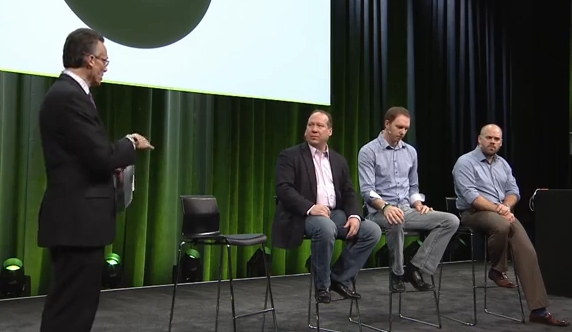 NEWS
NEWS
 NEWS
NEWS
 NEWS
NEWS
![]() Dave Vellante, Wikibon analyst and theCUBE co-host, was invited to moderate a Panel Discussion at the fifth edition of the Open Compute Project Summit in San Jose, California this week.
Dave Vellante, Wikibon analyst and theCUBE co-host, was invited to moderate a Panel Discussion at the fifth edition of the Open Compute Project Summit in San Jose, California this week.
Just before the guests took the stage, George Slessman (CEO and Product Architect at IO) made a quick presentation to the audience, right from his iPhone, with the purpose to show how the data center is going to be for the enterprises.
“We’re focused on the enterprise world and how they consume compute. The days of cardboard boxes being shipped to data centers, unboxed, put in racks, custom configured, custom cabled and custom managed is coming to an end,” warned Slessman. “I want to demonstrate how we can stand up a virtual instance on an iPhone, across an LT network, across the country, in a Tier 3 certified data center with a 600+ enterprise customers running across the global network.”
In about five clicks and just as many settings, the virtual server was up and running, taking less than three minutes.
“This is the data center as an API,” explained Slessman. “That’s what the world of compute deployment is going to be. If people don’t see what’s coming, they’re going to get run over by it.”
George Slessman was then joined on stage by Dave Vellante as the chairman of the debate and by Tim Lyons from Merck and Cole Crawford from OCP. The talk was called “Open Architecture: The Tipping Point for Enterprise Cloud.”
Vellante started off by quickly sharing a couple of stats from Wikibon.org:
Vellante quoted his CUBE partner, John Furrier, who identified “an engineering reset,” that is enabling us to release the shackles of hardware barriers.
Vellante’s first introductory question was addressed to Crawford, who was asked to talk about the state of the open source movement, specifically in relations to the architecture.
“In terms of architecture, on the software side, we’re well into the game; open source has proved itself way back into the 90’s, but on the hardware side you’re getting the same critical eye that you used to get back in the day about Linux,” Crawford responded.
Lyons, coming from a financial background, was asked to provide his input regarding the enterprise tipping point, focusing on enterprise infrastructure generally and cloud specifically. As we know, financial businesses tend to be the harbringer of major trends. However, in the healthcare-pharma industry it’s a little bit early.
“In the future, I think the opportunities around analytics are important – for the drug development as well for improving the manufacturing. Analyzing the real-world data may lead to more personalized medicine,” said Lyons. As for scaling out the technology that a lot of companies like Facebook have done, “if you’re going to start analyzing massive amounts of data, leveraging the wave of Open Compute and OpenStack is critical.”
.
Vellante turned to Slessman to find out “what’s wrong with the current model.”
“Unfortunately it’s a dollar issue,” replied the IO CEO. “The compute necessity in the large enterprise space (and we’re fortunate enough to do business with the largest consumers of IT in the world) is growing by the day, and these folks are looking up at ways to deliver it at lower operating costs.”
Apart from the cost itself, “the complexity of the environments in these large organizations exceeds anything that you’ll see anywhere.” But, however difficult, change is unavoidable. “The customer is demanding a scale methodology for delivering applications to their users. Everyone forgets what the goal of IT is: to keep a user in a persistent or non-persistent connection to an application. That should be our goal, and it should be done in the most efficient and most economical way possible,” summarized Slessmen.
Lyons recognized the importance of the existing infrastructure for most businesses. He declared to be “more focused on thinking how to leverage the new models,” while Crawford cited a Gartner study stating that “the best companies are those who strive to innovate.”
Nevertheless, George Slessman crossed all the t’s and acknowledged we are indeed “getting to a tipping point where the adoption of new models will no longer be an option but a necessity.”
“In order to keep up with your peer group, you’re going to have to adopt some type of industrial style compute capacity to run your environment driver applications,” said Slessman. “I’m a huge believer that the data center should be an application-level decision (not the enterprise-level decision which it is today).” And last, but not least, “the data center should be configured based on the application call.”
Vellante wrapped up the debate reminding the audience of the IO cloud presentation and the virtual instance he managed to set up from his smartphone. That solution requires zero licences and offers a better service, with no expensive or poor support whatsoever.
Support our mission to keep content open and free by engaging with theCUBE community. Join theCUBE’s Alumni Trust Network, where technology leaders connect, share intelligence and create opportunities.
Founded by tech visionaries John Furrier and Dave Vellante, SiliconANGLE Media has built a dynamic ecosystem of industry-leading digital media brands that reach 15+ million elite tech professionals. Our new proprietary theCUBE AI Video Cloud is breaking ground in audience interaction, leveraging theCUBEai.com neural network to help technology companies make data-driven decisions and stay at the forefront of industry conversations.